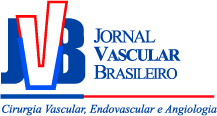Abstract
Abstract: Background: Determination of predictors that can affect development of atherosclerosis progression in the postoperative period is an urgent problem in vascular surgery.
Objectives: Integrated assessment of markers of apoptosis and cell proliferation in atherosclerotic lesions and their progression after surgery in patients with peripheral arterial diseases.
Methods: The investigation included 30 patients with stage IIB-III peripheral arterial disease. All patients have undergone open surgical interventions on the arteries of the aorto-iliac and femoral-popliteal segments. During these interventions, intraoperative specimens were obtained from the vascular wall with atherosclerotic lesions. The following values were evaluated: VEGF А165, PDGF BB, and sFas. Samples of normal vascular wall were obtained from post-mortem donors and used as a control group.
Results: The levels of Bax and p53 were increased (p<0.001) in samples from arterial wall with atherosclerotic plaque, while sFas values were reduced (p<0.001), compared to their levels in control samples. Values of PDGF BB and VEGF A165 were 1.9 and 1.7 times higher in atherosclerotic lesion samples (p=0.001), in comparison with the control group. The levels of p53 and Bax were increased against a background of reduced sFas levels in samples with progression of atherosclerosis compared to their baseline values in samples with atherosclerotic plaque (p<0.05).
Conclusions: Initially increased values of the Bax marker against a background of reduced sFas values in vascular wall samples from patients with peripheral arterial disease is associated with risk of atherosclerosis progression in the postoperative period.
Supplementary Material
Keywords
atherosclerosis, apoptosis, vascular wall, cell proliferation, Вах, sFas
Resumo
Resumo: Contexto: A determinação de preditores que possam influenciar o desenvolvimento da progressão da aterosclerose no período pós-operatório é um problema urgente em cirurgia vascular.
Objetivos: Realizar uma avaliação integral de marcadores de apoptose e proliferação celular nas lesões ateroscleróticas e sua progressão após cirurgia em pacientes com doenças arteriais periféricas.
Métodos: A investigação incluiu 30 pacientes com doenças arteriais periféricas de estágio IIB-III. Todos os pacientes foram submetidos a intervenções operatórias abertas nas artérias dos segmentos aorto-ilíaco e fêmoro-poplíteo. Durante a intervenção, foi obtido material intraoperatório da parede vascular com lesões ateroscleróticas. Foram avaliados os seguintes valores: VEGF A165, PDGF BB e sFas. Como grupo controle, amostras de parede vascular normal foram obtidas de doadores post-mortem.
Resultados: O nível de Bax e p53 (p < 0,001) em amostras de parede arterial com placa aterosclerótica estava elevado em meio a valores reduzidos de sFas (p < 0,001) em comparação ao grupo controle. Os valores de PDGF BB e VEGF A165 foram 1,9 e 1,7 vezes maiores, respectivamente, nas amostras com lesão aterosclerótica (p = 0,001) do que no grupo controle. O nível de Bax e p53 e Bax estava elevado no contexto de nível reduzido de sFas em amostras com progressão da aterosclerose em comparação com seus valores basais em amostras com placa aterosclerótica (p < 0,05).
Conclusões: Níveis inicialmente elevados do marcador Bax no contexto de valores reduzidos de sFas na parede vascular em pacientes com doença arterial periférica estão associados a risco de progressão da aterosclerose no período pós-operatório.
Palavras-chave
aterosclerose, apoptose, parede vascular, proliferação celular, Вах, sFas
References
1 Geiger MA, Guillaumon AT. Primary stenting for femoropopliteal peripheral arterial disease: analysis up to 24 months. J Vasc Bras. 2019;18:e20160104. http://dx.doi.org/10.1590/1677-5449.010416. PMid:31191625.
2 Conte MS, Bradbury AW, Kolh P, et al. Global vascular guidelines on the management of chronic limb-threatening ischemia. J Vasc Surg. 2019;69(6S):3S. http://dx.doi.org/10.1016/j.jvs.2019.02.016. PMid:31159978.
3 Chen SL, Whealon MD, Kabutey NK, Kuo IJ, Sgroi MD, Fujitani RM. Outcomes of open and endovascular lower extremity revascularization in active smokers with advanced peripheral arterial disease. J Vasc Surg. 2017;65(6):1680-9. http://dx.doi.org/10.1016/j.jvs.2017.01.025. PMid:28527930.
4 Riascos-Bernal DF. Perking up strategies to control restenosis. JACC Basic Transl Sci. 2020;5(3):264-6. http://dx.doi.org/10.1016/j.jacbts.2020.01.013. PMid:32215377.
5 Paone S, Baxter AA, Hulett MD, Poon IKH. Endothelial cell apoptosis and the role of endothelial cell-derived extracellular vesicles in the progression of atherosclerosis. Cell Mol Life Sci. 2019;76(6):1093-106. http://dx.doi.org/10.1007/s00018-018-2983-9. PMid:30569278.
6 Kalinin RE, Suchkov IA, Klimentova EA, Shanaev IN. Influence of the geometry of the proximal anastomosis, markers of apoptosis and cell proliferation on the long-term results of patency after reconstructive interventions on the arteries of the femoropopliteal segment. Kazan Med J. 2021;102(6):855-61. http://dx.doi.org/10.17816/KMJ2021-855.
7 Kalinin RE, Suchkov IA, Klimentova EA, Shchulkin AV. Markers of development of restenosis of the reconstruction zone after endovascular interventions on the arteries of the lower limbs. Russian Sklifosovsky J Emergency Med Care. 2021;10(4):669-75. http://dx.doi.org/10.23934/2223-9022-2021-10-4-669-675.
8 Qin C, Liu Z. In atherogenesis, the apoptosis of endothelial cell itself could directly induce over-proliferation of smooth muscle cells. Med Hypotheses. 2007;68(2):275-7. http://dx.doi.org/10.1016/j.mehy.2006.07.037. PMid:17011140.
9 Kalinin RE, Suchkov IA, Klimentova EA, Egorov AA, Povarov VO. Apoptosis in vascular pathology: present and future. I.P. Pavlov Russian Med Biol Herald. 2020;28(1):79-87. http://dx.doi.org/10.23888/PAVLOVJ202028179-87.
10 Pauli N, Kuligowska A, Krzystolik A, et al. The circulating vascular endothelial growth factor is only marginally associated with an increased risk for atherosclerosis. Minerva Cardioangiol. 2020;68(4):332-8. http://dx.doi.org/10.23736/S0026-4725.20.04995-6. PMid:32326675.
11 Kazlauskas A. PDGFs and their receptors. Gene. 2017;614:1-7. http://dx.doi.org/10.1016/j.gene.2017.03.003. PMid:28267575.
12 Miot HA. Tamanho da amostra em estudos clínicos e experimentais. J Vasc Bras. 2011;10(4):275-8. http://dx.doi.org/10.1590/S1677-54492011000400001.
13 Narkevich AN, Vinogradov KA. Methods for determining the minimum required sample size in medical research. Social Aspects Popul Health. 2019;65(6):10. http://dx.doi.org/10.21045/2071-5021-2019-65-6-10.
14 Bian W, Jing X, Yang Z, et al. Downregulation of LncRNA NORAD promotes Ox-LDL-induced vascular endothelial cell injury and atherosclerosis. Aging. 2020;12(7):6385-400. http://dx.doi.org/10.18632/aging.103034. PMid:32267831.
15 Li CJ. Oxidative stress and mitochondrial dysfunction in human diseases: pathophysiology, predictive biomarkers, therapeutic. Biomolecules. 2020;10(11):1558. http://dx.doi.org/10.3390/biom10111558. PMid:33207541.
16 Kavurma MM, Rayner KJ, Karunakaran D. The walking dead: macrophage inflammation and death in atherosclerosis. Curr Opin Lipidol. 2017;28(2):91-8. http://dx.doi.org/10.1097/MOL.0000000000000394. PMid:28134664.
17 Gonzalez L, Trigatti BL. Macrophage apoptosis and necrotic core development in atherosclerosis: a rapidly advancing field with clinical relevance to imaging and therapy. Can J Cardiol. 2017;33(3):303-12. http://dx.doi.org/10.1016/j.cjca.2016.12.010. PMid:28232016.

